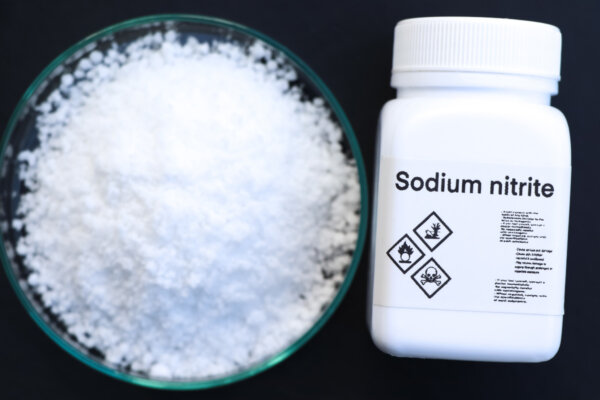![]() Suicide by sodium nitrite, a chemical compound used in preserving meats, fertilizers, and other applications, has been increasing—but poison centers are missing these cases, a new study found.
Suicide by sodium nitrite, a chemical compound used in preserving meats, fertilizers, and other applications, has been increasing—but poison centers are missing these cases, a new study found.
The authors analyzed reports from two medical examiner jurisdictions in New York and found almost as many cases of sodium nitrite suicide as those reported in the entire national database.
“Although national poison data estimated 13 to 20 deaths from 2019 and 2020, our findings confirmed 11 in our local jurisdictions alone,” the authors wrote.
Underreported Sodium Nitrite Cases
The new study, a retrospective case series published in JAMA Network Open, analyzed sodium nitrite exposures and fatalities through reports from medical examiners and poison centers in two urban jurisdictions in New York State from 2000 to 2022.
The study revealed significant discrepancies between the number of sodium nitrite-related suicide cases reported by medical examiners and those coded as intentional exposures by poison centers in the same New York State locales.
The authors confirmed 36 sodium nitrite suicides from 2019 to 2022 between the two jurisdictions, while poison center databases confirmed only two cases to be intentional exposures that were lethal or caused major outcomes.
Another National Poison Data System analysis found only 33 deaths from 2019 to 2022—almost equivalent to the 36 cases identified in New York alone, the authors noted.
The authors said that many cases are not being reported to poison centers.
Poison centers continuously upload data on poison exposures to the National Poison Database System roughly every 9.5 minutes, enabling real-time tracking of poisoning trends. This quick data turnover is crucial for alerting authorities about clusters of deaths and toxic hazards directly impacting public safety.
Expert’s Insight
Sodium nitrite poisoning cases primarily occur in deliberate suicide attempts rather than accidental ingestions, as the chemical is used in pest control and small quantities in food, Dr. Jared Ross, an experienced emergency physician, told The Epoch Times.
Need for Improved Communication
A 2011 study published in Forensic Science International found potential disagreements on cause of death between medical toxicologists and medical examiners, indicating a need for unified real-time surveillance and formal communication processes.
Establishing clear communication and a collaborative system between poison centers and medical examiners could help reduce discrepancies in death reporting and enhance data reliability.
Lethal Agent With Easy Access and Availability
While nonintentional intoxications with sodium nitrite tend to be rare, it was only after 2010 that the preservative became a more common method of suicide. Today, there is an increase in sodium nitrite’s use among young adults as a planned suicide method, particularly among white male students diagnosed with depressive disorders and a history of suicidal thoughts.
Several reports link the rising trend in intentional sodium nitrite exposure to the easy access and rapid dissemination of information online, particularly through forums where suicides are openly discussed and shadow markets that advocate for its use for suicide.
Many people on these forums give information on its procurement and how to use sodium nitrite for euthanasia, promoting it as an effective and relatively painless method. One such forum purportedly serves as a space for people to discuss suicide without judgment.
An analysis of posts on the forum revealed that sodium nitrite was the most discussed method of suicide, with mentions significantly increasing from 2018 to 2020.
Suicide forums say that taking sodium nitrite alongside antihistamines and antiemetic drugs will enhance absorption and reduce the likelihood of other symptoms from ingestion.
Sodium Nitrite in Meat
Sodium nitrite is an odorless, yellowish-white powder or granule commonly used as a color fixative in meats and fish, as a treatment and finishing agent for metals, and intravenously as an antidote for cyanide poisoning.
The toxic effect of sodium nitrite stems from its oxidizing properties. Upon ingestion, it can induce methemoglobinemia, a potentially fatal condition in which hemoglobin loses its ability to carry oxygen to body tissues. According to a study of two case reports published in Medicine, a lethal dose of sodium nitrite ranges from 0.7 to 6 grams, with approximately 2.6 grams considered fatal, meaning that less than a teaspoon could be deadly.
The study also mentioned that methemoglobinemia can be treated using methylene blue.
Is It Really Painless?
Shay, a nursing assistant, lost her sibling to suicide by sodium nitrite.
“He ordered sodium nitrite through a new Amazon account so no one would know, and told my parents he was going to town,” she noted. “It wasn’t until hours later that the cops showed up to tell them what happened.”
Sodium nitrite has been promoted on various pro-suicide forums for being relatively painless.
Sodium Nitrite Poisoning Signs
Research shows that suicidal ideation can fluctuate. More than half of those who attempt suicide succeed on their first attempt, indicating that people with fleeting thoughts of suicide, who may not genuinely wish to die, can still succeed in their attempts.
Many who survive a suicide attempt often regret the attempt. With potent toxins like sodium nitrite, time is of the essence; administering an antidote quickly can be crucial.
- Bluish discoloration of hands, fingertips, and toes
- Headaches
- Redness of the face, neck, and chest
- Altered skin color
- Significant drop in blood pressure when standing, accompanied by an increased heart rate
- Altered mental state
- Loss of consciousness
- Nausea
- Vomiting
- Diarrhea
- Irregular heartbeat
Recognizing the signs of sodium nitrite poisoning and responding quickly can be lifesaving. This underscores the importance of awareness and timely intervention in preventing such tragedies.











